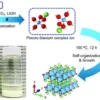Gel vs Lithium Battery Showdown: Which Powers Your Needs Best?
Are you torn between gel batteries and lithium batteries for your solar system, EV, or off-grid setup? Choosing the right battery can supercharge your project’s performance while saving you time and money. At li-ess, we’ve seen firsthand how the right power source transforms everything from RVs to renewable energy systems. In this ultimate gel vs lithium battery showdown, we’ll break down energy density, lifespan, cost, and more, based on real-world insights and industry expertise. Whether you’re powering a remote cabin or an electric vehicle, this guide will help you decide which battery comes out on top. Ready to find the perfect fit for your needs? Let’s dive in!
Gel vs Lithium Battery Showdown What Are Gel Batteries What Are Lithium Batteries Why Compare
When deciding between gel battery vs lithium battery, it’s important to understand what each technology offers and why this comparison matters for your needs.
What Are Gel Batteries
Gel batteries are a type of sealed lead-acid battery where the electrolyte is suspended in a silica-based gel. This design offers several advantages over traditional flooded lead-acid batteries:
- Maintenance-free operation – no need to check electrolyte levels regularly
- Improved vibration resistance making them suitable for rougher environments
- Lower risk of leaks and corrosion thanks to their sealed design
- Commonly used in solar power setups, mobility scooters, and deep cycle applications where steady, reliable power is essential.
Despite being older technology, gel batteries remain popular for their durability and ease of use, especially in off-grid solar systems or backup power situations.
What Are Lithium Batteries
Lithium batteries, particularly lithium-ion and LiFePO4 types, use lithium-based chemistry to store energy. They have revolutionized battery technology by offering:
- Higher energy density – more power stored in less space
- Faster charging capabilities
- Longer lifespan with more charge-discharge cycles
- Lighter weight compared to lead-acid options
- Greater depth of discharge without damage.
These qualities make lithium batteries ideal for electric vehicles, portable electronics, and increasingly for solar energy storage and other demanding applications.
Why Compare Gel and Lithium Batteries
Comparing gel and lithium batteries isn’t just about picking the newest tech. It’s about matching the right battery to your specific needs in terms of cost, performance, maintenance, and safety.
- Are you looking for long-term savings and high efficiency?
- Is initial price a major concern?
- Do you need a battery that performs well in temperature extremes or requires minimal upkeep?
Understanding the differences between gel and lithium batteries can help you avoid costly mistakes and find the best fit for your power needs. Whether you’re upgrading your solar system or choosing batteries for electric vehicles, knowing what each technology offers is key.
In the next sections, we’ll break down a detailed comparison covering energy density, lifespan, cost, safety, and more—arming you with all the info you need to make an informed choice.
If you’re curious about lithium battery safety and performance in golf carts, check out this helpful resource on are lithium golf cart batteries better for practical insights.
Gel vs Lithium Battery Head-to-Head Comparison

When it comes to choosing between a gel battery vs lithium battery, understanding their differences in key performance areas is crucial. Let’s break down how they stack up in energy density, lifespan, charging, cost, safety, temperature tolerance, and where each fits best.
Energy Density and Efficiency
Lithium batteries clearly lead in energy density. They pack more power into a smaller, lighter package, making them ideal for applications where space and weight matter, like electric vehicles or portable solar systems. Gel batteries, while reliable, are heavier and less efficient, with lower energy density, meaning they store less power per unit of weight or volume.
Lifespan and Cycle Life
One standout for lithium batteries is their long lifespan and cycle life. A typical lithium-ion or LiFePO4 battery easily handles 2,000 to 5,000 charge cycles, often lasting 8-10 years or more with proper care. In contrast, gel batteries generally offer fewer cycles—typically 500 to 1,000—and a shorter overall service life, usually around 3-5 years. This makes lithium-ion the better choice for heavy, long-term use.
Charging Speed
Thanks to their chemistry, lithium batteries charge much faster. They support rapid charging without overheating, which is a big plus if you need quick turnaround times. Gel batteries require slower, more controlled charging to avoid damage, extending downtime.
Cost Considerations
Cost is often the biggest factor. Gel batteries come with a lower upfront price, making them attractive for budget-conscious users or those wanting a simple replacement. However, lithium batteries cost more initially but offer better value over time due to their longer lifespan and efficiency. When looking at total cost of ownership, lithium often wins out.
Safety and Maintenance
Gel batteries are known for being low maintenance and safe, thanks to their sealed design that prevents leaks. They handle overcharging better than traditional flooded batteries but still require occasional checks to maintain state of health. Lithium batteries also have strong safety records, particularly LiFePO4 cells, which are chemically stable and less prone to thermal runaway. However, lithium batteries usually require battery management systems (BMS) to monitor and protect against overcharge, undercharge, and temperature extremes.
Temperature Performance
Temperature affects battery performance differently. Gel batteries perform reasonably well in cold climates but suffer efficiency drops in extreme heat. Lithium batteries, depending on the chemistry, can tolerate a wider temperature range but may lose capacity in freezing conditions. Still, many lithium models include built-in management systems to handle this dynamically.
Applications and Suitability
- Gel batteries excel in stationary uses, such as backup power systems and solar setups where moderate cycling and slow discharge are typical.
- Lithium batteries shine in high-demand applications like electric vehicles, marine use, portable clean energy systems, and anywhere weight and fast charging matter.
For a detailed example of switching to lithium, you might check out how to convert your golf cart to a lithium battery for increased performance and lifespan.
Understanding these differences helps you figure out which battery suits your specific needs and budget best. Next, we’ll dive into how to pick the right battery for your setup and what checklist to use before making the call.
Which Battery Wins for Your Needs Gel Battery vs Lithium Battery

Choosing the right battery depends on your specific needs, budget, and application. Both gel batteries and lithium batteries have their strengths, so let’s break down the key considerations to help you decide.
Choosing the Right Battery for Your Application
-
Energy Needs: If you need high energy density and longer runtime without extra weight, lithium batteries are the clear winner. Gel batteries are heavier and bulkier but still reliable for steady, less demanding loads like backup power or basic solar setups.
-
Budget: Gel batteries come with a lower upfront cost, which can be attractive for tight budgets. Lithium batteries, especially LiFePO4 types, have a higher price but offer better long-term value thanks to their lifespan and efficiency.
-
Maintenance: Gel batteries require regular maintenance and monitoring to prevent sulfation and optimize lifespan. Lithium batteries need far less upkeep, making them more convenient for users who want a plug-and-play solution.
-
Lifespan and Cycle Life: Lithium batteries generally last 2-3 times longer than gel batteries. If you want longevity, fewer replacements, and better performance over time, lithium is your best bet.
-
Charging Speed: Lithium batteries charge significantly faster, a major advantage if you’re on the go or need frequent recharge cycles. Gel batteries take longer to charge and are less efficient in energy transfer.
-
Safety and Temperature Performance: Gel batteries handle extreme temperatures better but can still suffer in very cold or hot conditions. Lithium batteries include built-in safety features but may require temperature management systems in harsh environments.
Decision-Making Checklist
- What’s your typical usage? (e.g., solar system, golf cart, backup power)
- How important is battery weight and size?
- What’s your budget for upfront investment versus long-term savings?
- How much maintenance are you willing to perform?
- How fast do you need to recharge your batteries?
- Will your batteries face extreme weather or temperature swings?
- Do you prioritize lifespan and cycle life?
Call to Action
Before making your final call, consider consulting with experts or checking detailed guides on specific applications like golf cart battery upgrades or solar system integrations. For example, you can learn more about converting traditional batteries to lithium here: Can You Convert a 48V Golf Cart to Lithium Battery or explore if lithium golf cart batteries are worth it Are Lithium Golf Cart Batteries Worth It.
Choosing the right battery means matching the technology to your lifestyle and demands. Whether you go gel or lithium, the right choice will power your equipment reliably and efficiently.
Environmental and Practical Considerations for Gel vs Lithium Batteries
Sustainability and Disposal
When comparing gel battery vs lithium battery from an environmental standpoint, it’s important to look at both sustainability and disposal methods.
- Gel Batteries: These use a gel electrolyte, making them leak-resistant and relatively safe to handle. However, gel batteries contain lead and acid, which are hazardous if not disposed of properly. Lead-acid battery recycling is well-established in the US, but improper disposal can cause soil and water contamination.
- Lithium Batteries: Lithium-ion and LiFePO4 batteries offer better energy efficiency, which means less waste and fewer replacements over time. Still, lithium batteries require specialized recycling due to the metals involved, including lithium, cobalt, and nickel. Recycling options are growing but are less widespread compared to lead-acid.
Bottom line: Lithium batteries generally have a smaller environmental footprint due to longer life and energy efficiency, but proper recycling infrastructure is key. For gel batteries, stick to certified drop-off points to avoid environmental harm.
Practical Tips for Battery Use and Maintenance
Whether you lean towards gel or lithium-ion, here are key practical tips to extend battery life and keep things safe:
- Regular Inspection: Check for any signs of damage, leaks, or corrosion especially in gel batteries.
- Proper Charging: Use chargers designed specifically for your battery type. Overcharging can shorten lifespan. Lithium batteries often require smart chargers with precise voltage control.
- Temperature Control: Keep batteries in moderate temperature environments. Gel batteries may suffer in freezing conditions, while lithium batteries perform poorly in extreme heat.
- Storage: Store batteries in a cool, dry place. For long periods, keep lithium batteries at about 50% charge to avoid degradation.
- Disposal: Always recycle batteries properly. Many US states have designated drop-off locations for both gel and lithium batteries to prevent hazardous waste issues.
By understanding the environmental impact and applying these practical tips, you can get the most out of either gel or lithium batteries while keeping your carbon footprint in check.











Add comment